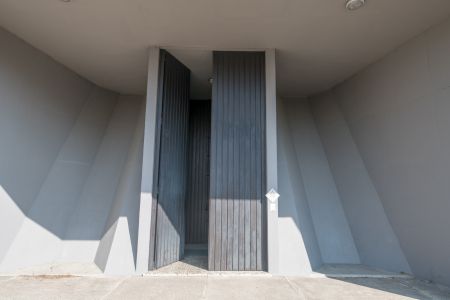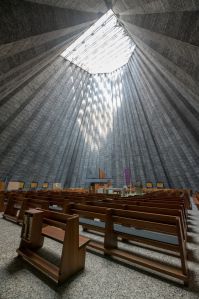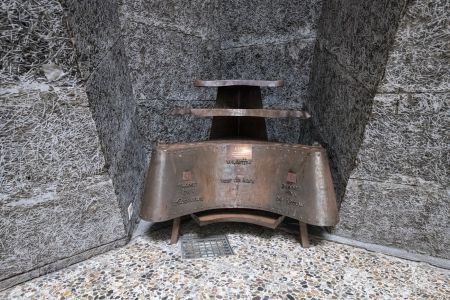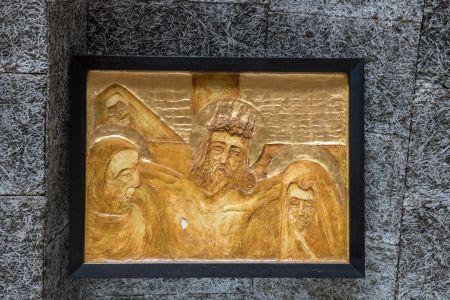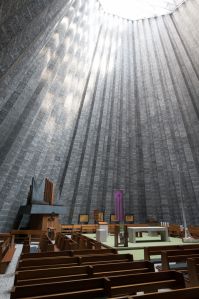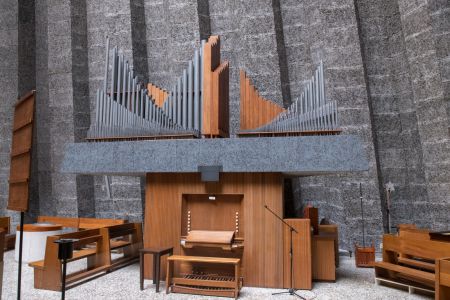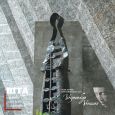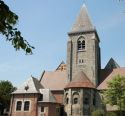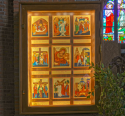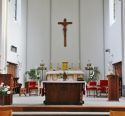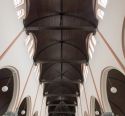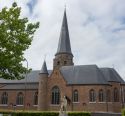Church | 1966 | Modern | Catholic Church




Map
Opening hours
01 January - 31 December
Mon 9.30 - 17.30
Tue 9.30 - 17.30
Wed 9.30 - 17.30
Thu 9.30 - 17.30
Fri 9.30 - 17.30
Sat 9.30 - 17.30
Sun -
Reduced opening hours for the church during the works (because access is difficult): only Saturday 9.30 - 17.30
Guided tour
Véronique De Wijze +32 497 03 41 46
Religious offices
Description
The construction of this modernist pearl by architect Leon Stijnen and his associate colleague Paul De Meyer began in 1963 and was completed in 1966. The two architects aimed to create a self-supporting structure with walls 8.5 cm thick.
Leon Stijnen (1899 - 1990) was a fashionable architect of the modernist style in Belgium. As Director of the Institut National Supérieur d'Architecture et des Arts décoratifs in Brussels (1950), he marked the modernist architecture in Belgium with his seal for a decade. This is how he created the Kursaal in Ostend and all the buildings of the Singel in Antwerp.
The architect was very keen that the exterior appearance should retain the original colour of the concrete, but the church was nevertheless painted white later. The plan is in the form of an irregular hexagon with a diameter of 30 metres. The whole thing looks like a truncated pyramid. Because of this form, Stijnen made sure to put a central source of light in it.
For the interior, Stijnen and De Meyer seem to have literally translated the ancient text of the Bible: "God's tent among his people". This biblical reference is not only expressed in the aspect of the tent, but several elements refer to the Holy Scriptures.
With the exception of the confessionals (made of wood), all the furniture of the church, altar, baptismal font, credence, desk, as well as the support of the tabernacle were made of prefabricated polished concrete. The statue of Notre-Dame-des-Flandres was designed by Marcel Notebaert and executed by the goldsmith Adhemar Verdroemme. Notebaert also made the statue of Saint Rita. Firmin Colardyn added the expressionist Way of the Cross in bas relief. His brother Lieven Colardyn is the author of the head of Christ.
Leon Stijnen (1899 - 1990) was a fashionable architect of the modernist style in Belgium. As Director of the Institut National Supérieur d'Architecture et des Arts décoratifs in Brussels (1950), he marked the modernist architecture in Belgium with his seal for a decade. This is how he created the Kursaal in Ostend and all the buildings of the Singel in Antwerp.
The architect was very keen that the exterior appearance should retain the original colour of the concrete, but the church was nevertheless painted white later. The plan is in the form of an irregular hexagon with a diameter of 30 metres. The whole thing looks like a truncated pyramid. Because of this form, Stijnen made sure to put a central source of light in it.
For the interior, Stijnen and De Meyer seem to have literally translated the ancient text of the Bible: "God's tent among his people". This biblical reference is not only expressed in the aspect of the tent, but several elements refer to the Holy Scriptures.
With the exception of the confessionals (made of wood), all the furniture of the church, altar, baptismal font, credence, desk, as well as the support of the tabernacle were made of prefabricated polished concrete. The statue of Notre-Dame-des-Flandres was designed by Marcel Notebaert and executed by the goldsmith Adhemar Verdroemme. Notebaert also made the statue of Saint Rita. Firmin Colardyn added the expressionist Way of the Cross in bas relief. His brother Lieven Colardyn is the author of the head of Christ.
KIKIRPA : Photo-library on line




